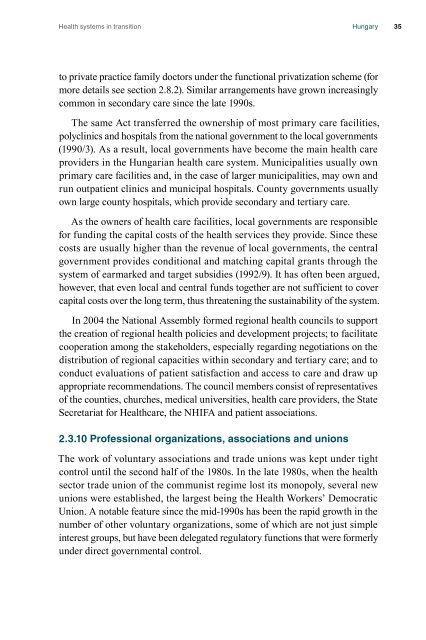Health Systems in Transition - Hungary - World Health Organization ...
Health Systems in Transition - Hungary - World Health Organization ...
Health Systems in Transition - Hungary - World Health Organization ...
You also want an ePaper? Increase the reach of your titles
YUMPU automatically turns print PDFs into web optimized ePapers that Google loves.
<strong>Health</strong> systems <strong>in</strong> transition <strong>Hungary</strong> 35<br />
to private practice family doctors under the functional privatization scheme (for<br />
more details see section 2.8.2). Similar arrangements have grown <strong>in</strong>creas<strong>in</strong>gly<br />
common <strong>in</strong> secondary care s<strong>in</strong>ce the late 1990s.<br />
The same Act transferred the ownership of most primary care facilities,<br />
polycl<strong>in</strong>ics and hospitals from the national government to the local governments<br />
(1990/3). As a result, local governments have become the ma<strong>in</strong> health care<br />
providers <strong>in</strong> the Hungarian health care system. Municipalities usually own<br />
primary care facilities and, <strong>in</strong> the case of larger municipalities, may own and<br />
run outpatient cl<strong>in</strong>ics and municipal hospitals. County governments usually<br />
own large county hospitals, which provide secondary and tertiary care.<br />
As the owners of health care facilities, local governments are responsible<br />
for fund<strong>in</strong>g the capital costs of the health services they provide. S<strong>in</strong>ce these<br />
costs are usually higher than the revenue of local governments, the central<br />
government provides conditional and match<strong>in</strong>g capital grants through the<br />
system of earmarked and target subsidies (1992/9). It has often been argued,<br />
however, that even local and central funds together are not sufficient to cover<br />
capital costs over the long term, thus threaten<strong>in</strong>g the susta<strong>in</strong>ability of the system.<br />
In 2004 the National Assembly formed regional health councils to support<br />
the creation of regional health policies and development projects; to facilitate<br />
cooperation among the stakeholders, especially regard<strong>in</strong>g negotiations on the<br />
distribution of regional capacities with<strong>in</strong> secondary and tertiary care; and to<br />
conduct evaluations of patient satisfaction and access to care and draw up<br />
appropriate recommendations. The council members consist of representatives<br />
of the counties, churches, medical universities, health care providers, the State<br />
Secretariat for <strong>Health</strong>care, the NHIFA and patient associations.<br />
2.3.10 Professional organizations, associations and unions<br />
The work of voluntary associations and trade unions was kept under tight<br />
control until the second half of the 1980s. In the late 1980s, when the health<br />
sector trade union of the communist regime lost its monopoly, several new<br />
unions were established, the largest be<strong>in</strong>g the <strong>Health</strong> Workers’ Democratic<br />
Union. A notable feature s<strong>in</strong>ce the mid-1990s has been the rapid growth <strong>in</strong> the<br />
number of other voluntary organizations, some of which are not just simple<br />
<strong>in</strong>terest groups, but have been delegated regulatory functions that were formerly<br />
under direct governmental control.
















